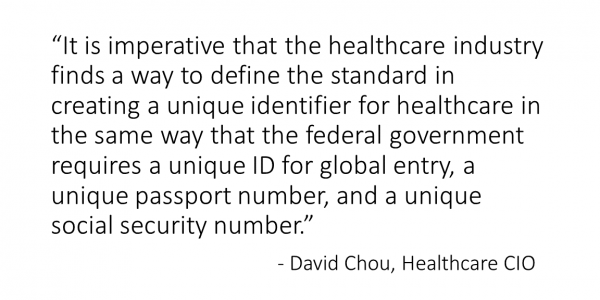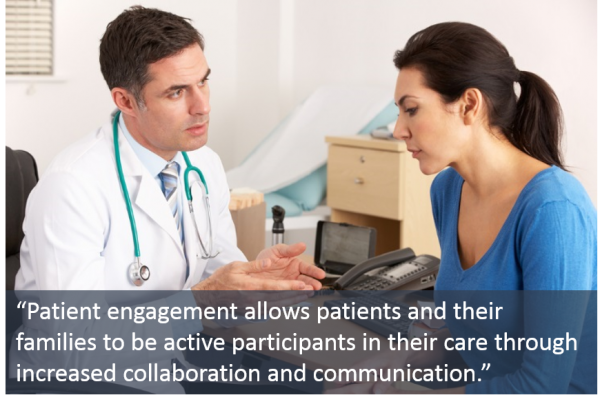HIMSS 2016 is right around the corner, in less than 2 weeks more than 40,000 people will gather in Las Vegas to explore the latest trends and challenges in the healthcare industry and discover cutting-edge technology solutions. As both a patient and a consumer, one topic I am looking forward to discussing at #HIMSS16 is patient and consumer engagement.
Patient and consumer engagement has been a hot topic for a while now and healthcare organizations are beginning to understand how valuable it can be to improving the health of individuals and populations.
Nothing would result in improving the health of the population (and decrease healthcare costs) more than having greater involvement/engagement by individuals in the healthcare process. — e-Patient
I was interested in getting a CIO’s perspective on patient and consumer engagement so I sat down with David Chou (@dchou1107), a healthcare executive with more than 13 years of experience in the healthcare industry, to get his thoughts on the evolution of patient and consumer engagement in healthcare.
KATE: How has the role of the patient evolved over the last 5 years and how have hospitals transformed their operations to accommodate this change?
DAVID: A patient experience five years ago was dramatically different than their experience now. Let’s use the example of a patient with an infection who needs to get the proper medication to get better. We used to have the traditional relationship between a patient and a doctor of where if the patient is sick, they have to rely on seeing their preferred/assigned doctor physically in order to get an assessment and acquire the requisite prescription for medication to feel better. Patients traditionally had to visit the doctor in order to receive any medical treatment.
Now, fast forward to the patient in 2016 and an era when patients have become more resourceful. Patients can now review relevant information regarding their symptoms to determine if there is a real need to see a doctor. This, in combination with the ability for healthcare providers and medical specialists to exchange information electronically allows patients to access their medical information at their convenience.
The advancement in medical technology also gives the modern-day patient the ability to choose their healthcare provider. Patients are no longer confined to a preferred/assigned doctor anymore. Patients are now able to pick a doctor based upon factors such as the convenience and overall preference. Specifically, the modern-day patient is able to choose a physician who is located closer to the patient’s locale, instead of being forced to travel a farther distance to see their preferred/assigned medical provider.
This ability to choose a physician at the patient’s convenience is due to the implementation of interoperability technology that allows sharing of relevant patient information. As consumers, modern-day patients clearly value convenience and it is evident that healthcare technology is also striving to pave the way to meet that goal. Interoperability provides the patient with the capacity to select a medical provider based on the patient’s convenience, and without interoperability, this capacity would not exist. For instance, with the implementation of this technology, a patient who is traveling in New York City can have their medical records electronically shared from their physician in Los Angeles to a medical provider in New York City with that patient’s consent. Additionally, the modern-day patient is now even able to seek treatment via a virtual care model by a doctor on their computer or mobile device. This patient can download their relevant medical record information and send the information electronically to the virtual care doctor, with whom they are consulting, for review.
KATE: There’s a lot of discussion about the need for patient empowerment, getting patients involved in their care and having some control over their episodes of care. What technologies are imperative to make this happen?
DAVID: There are a few technologies that will allow the patient to take control of their health:
Patient Portals
We will start first with the patient portal that is the initial entry for the patient to review and obtain their health information record. Healthcare providers must release the information to the patient and provide transparency. Patients want to have the transparency of their medical records by having access to lab results, imaging, and clinical notes. Some organizations are recognizing the value of transparency and are including physician notes to provide complete transparency. However, there may be times when the health information in the portal can lead to a false alarm for the patient, which the both the patient and medical provider must recognize and accept as a possibility.
In addition to the portal serving as a platform for patients to obtain their medical records, healthcare organizations must use patient portals as a way to engage with their patients. Patient portals should be a patient empowerment tool and deliver a personalized and engaging experience for their patients.
Wearable and mHealth
Wearables and mobile health (mHealth) are technologies that can empower patients. The current use of wearables may be found mostly in fitness tracking. However, the fitness population is not the target market when it comes to wearables. Instead, we want to target the population that does not work out regularly or who are not in the best of health. The goal would be to create an environment where the patients proactively monitor their own health for purposes of improvement or maintaining the status quo.
For instance, let’s consider a patient who has had open-heart surgery and COPD. It would be crucial for this patient to proactively monitor their heart condition through a wearable, which in turn electronically submits the data to the provider for review and assessment of the need for any adjustments in the patient’s current health plan. As such, it is clear that this consistent cycle of interaction using technology is vital in maximizing patient empowerment.
KATE: What is patient engagement’s biggest roadblock right now? Is it that much of the technology is still immature? Is it lack of standards, unwillingness of the patients, etc.?
DAVID: At this time I see two main roadblocks in patient engagement right now:
Engagement once they leave the hospital/clinic
The majority of healthcare organizations have effective procedures and strategies in place to engage with the patient when they are in the hospital or the clinic. However, most do not have any kind of plan in place once the patient leaves and that is a critical step where medical providers are failing in the engagement.
Here is an example of how providers can use technology to engage with the patient after the patient leaves the hospital or clinic. During their office visit, a patient with diabetes has been prescribed a low sodium. However, a few days later, that patient decides to get a bacon double cheeseburger at a fast food chain. At that specific moment, the healthcare provider should be able to engage with the patient to advise him against making such an unhealthy choice. In fact, the technology to share our location through our mobile devices is already in place. Utilizing this current technology to engage with the patient outside of the hospital or clinic would not only be a great way of improving patient engagement, but it would also assist in maximizing the patient’s health plan.
Interoperability Standards
Standards for interoperability is another area that is lagging in healthcare. When we think about interoperability and sharing patient data, the biggest challenge is identifying the correct patient, which becomes a patient safety concern.
Matching records to the correct person becomes increasingly complicated as healthcare entities share records electronically between different systems, such as EMR, lab, radiology and pharmacy. Every healthcare organization has multiple systems for clinical, administrative, and specialty services, which leads to an increased chance of identity errors when matching patient records internally within one organization. When we start sharing data between different health systems regionally and nationally, the chances of a match are high for individuals who share the exact name and birth date, leading to the need for additional identifying factors to be used when matching patient records.
It is imperative that the healthcare industry finds a way to define the standard in creating a unique identifier for healthcare in the same way that the federal government requires a unique ID for global entry, a unique passport number, and a unique social security number. The current scenario of not having a unique patient identifier is a big obstacle for the healthcare industry and it must be resolved to ensure patient privacy and safety.
I look forward to connecting with everyone at #HIMSS16 and continuing the discussion on patient and consumer engagement. Safe travels and please stop by and see me at booth #2871.
Follow me @KateDTuttle


